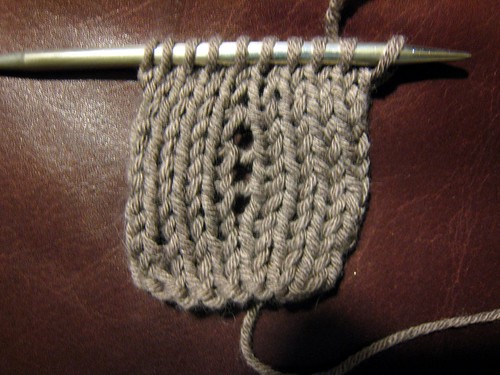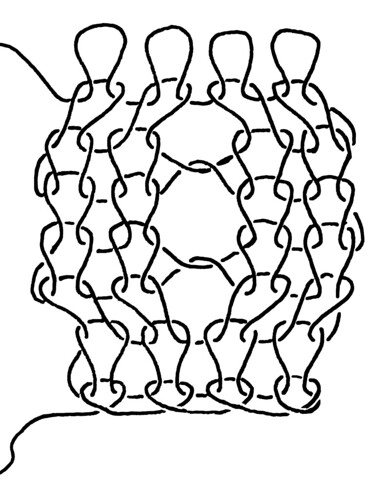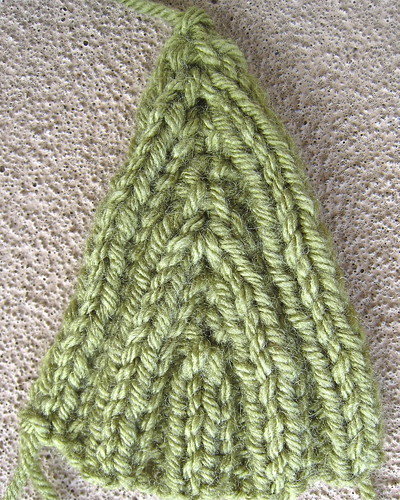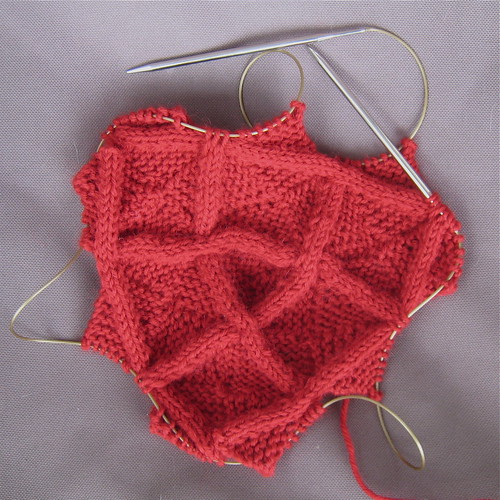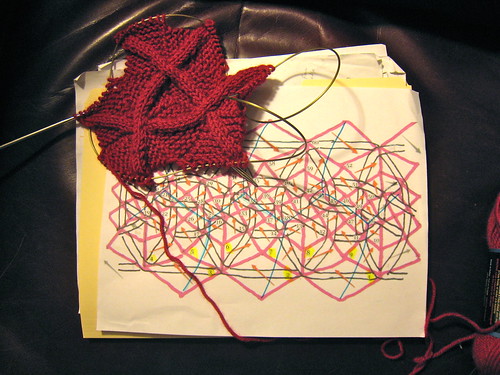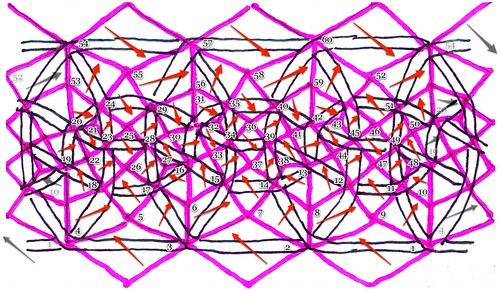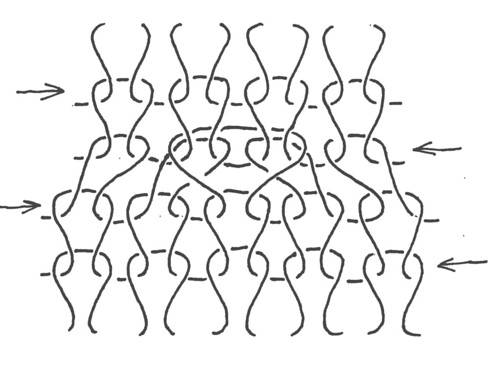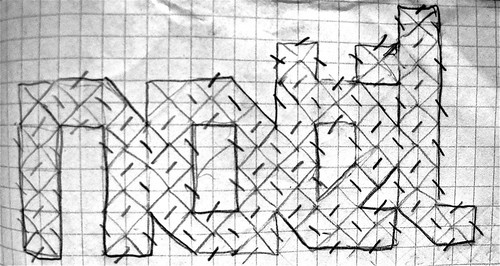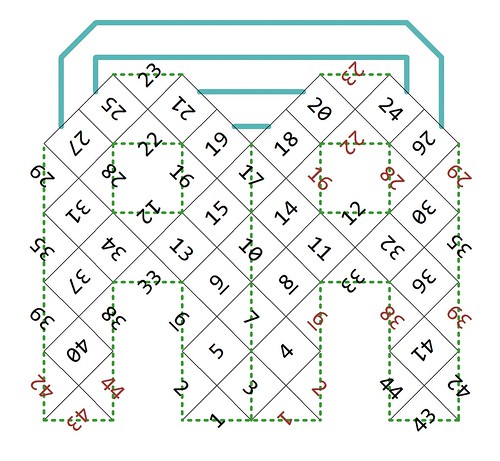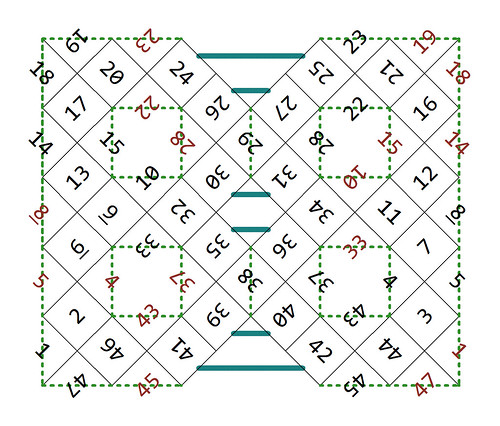I'm going for "subtle." This is the new eyelet I invented. So far, not so useful.
Monday, August 24, 2009
Sunday, August 23, 2009
Faux Tunisian stitch
Saturday, August 22, 2009
Subtle Decrease variation
The only difference is the way the two decreased stitches lean as you pull the loop through them.
I used wool this time to knit the swatch, so I could block the swatch to lie a little flatter. I also wanted to show how the increase/decrease line makes a good folding point.
I could see working this in the round, with one column of increases opposite one column of decreases, to make a bias headband or something. Edit: Oops. You really can't work this decrease in the round.
In this version, the increase is a little weirder to make. I'll probably make a video to show how it's done. With the other increase, you knit-1-purl-in-the-row-below-knit-1-into-the-same-stitch. With this one, you knit 1, widen the loop and manipulate it in a way that's hard to describe. Anyway.
Friday, August 21, 2009
60-square cabled entrelac ball
Garter-stitch squares with cables across the diagonals. The cables appear to be continuous, because the actual start and end points of the cables are hidden under another cable at the corners of the squares. I joined the squares together as I knitted them. The ball is knitted with one continuous piece of yarn (well, two, since I used more than one skein). There is one small grafted seam at the very end, but other than that the ball is seamless, so very sturdy and stretchy and good as a toy.
Thursday, August 20, 2009
"Subtle Decrease" in ribbing
It's reversible, except for a four-row shift. I'm knitting another swatch that will be truly reversible, but not mirror-symmetrical.
Wednesday, August 19, 2009
YouTube - "Subtle" increase
Now with subtitles! I hope the subtitles make my mumbling more understandable.
This is the corresponding increase to the "subtle decrease" I posted about earlier. The structure of this increase is exactly the same as the subtle decrease, only flipped 180 degrees. This increases the possibilities of symmetry in your knitting... you can create a fabric that looks essentially the same upside-down as right-side up.
"Subtle" increase
This is the corresponding increase to the "subtle decrease" I posted about earlier. The structure of this increase is exactly the same as the subtle decrease, only flipped 180 degrees. This increases the possibilities of symmetry in your knitting... you can create a fabric that looks essentially the same upside-down as right-side up.
Tuesday, August 18, 2009
Saturday, August 15, 2009
Friday, August 14, 2009
Cabled Entrelac cube 9 of 60 done
Sitting atop the diagram. There are only 51 squares to go! It's very symmetrical at this point...
Entrelac Cubes with Continuous Cables
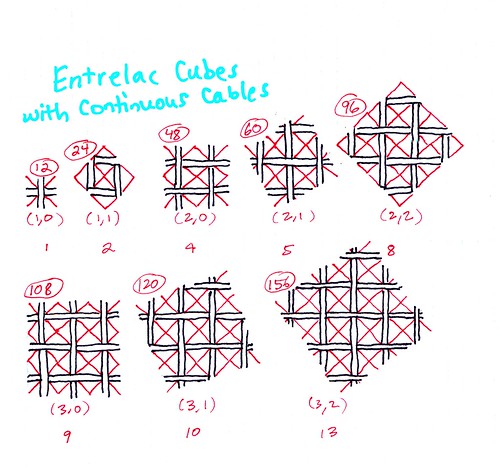 Entrelac Cubes with Continuous Cables, originally uploaded by fuzzyjay.
Entrelac Cubes with Continuous Cables, originally uploaded by fuzzyjay.The first 8 sizes possible of entrelac cubes that contain continuous cables. For each cube, I show one face of the cube, the number of squares in the whole cube, the coordinates of the edge of the base square (the face of the cube), and the number of squares as a multiple of the first (12-square) cube's squares.
Thursday, August 13, 2009
60-sq Cabled Entrelac Cube Diagram
OK, this is a mess, but it shows that this cube can be knitted in one continuous strand of yarn, with only one small grafted seam. There are a lot of cast-ons, though. Squares 1, 4, 10, 19, 20, 24, 29, 35, 40, and 54 are cast on in the middle of working the piece. (This can be done with a provisional cast-on or a backward-loop cast-on.)
60-square cabled entrelac cube diagram
This is a 60-square entrelac cube, punctured, cut, stretched out and laid flat. With a little repetition of the pattern formed by the braids and the squares. This is a much more elaborate braid than the others. There is a 48-square cabled entrelac cube in between the 24 and 60 that I haven't diagrammed yet.
60-sq entrelac cube with cables
This would be rather elaborate. I haven't figured out how to knit it yet.
Monday, August 10, 2009
Reversible Mock Garter Stitch

This pattern I invented produces a thick, double fabric that looks like garter stitch on both sides. Even better, unlike regular garter stitch you can change colors and each side looks the same.
The basic pattern has 3 rows, producing a reversible "ridge" of garter stitch on both sides.
For the illustrated swatch I cast on 18 stitches. I have added 3 stitches of I-cord selvedge on each side. This could be reduced to 2 or 1 stitch as desired.
I knitted six rows with each color to enable knitting 2 colors with straight needles.
It's possible to knit only 3 rows with each color if you use circular or double-pointed needles. This will allow you, when it's time to change colors, to slide the knitting along the needle to pick up the second color on the other end of the row just worked.
Reversible Mock Garter Stitch, Two color version
Cast on multiple of 2 stitches plus 6.Row 1: (Color A) Knit 3, *purl 1, knit 1, repeat from * to last 3 stitches, end slip 3 with yarn in front of needle. Row 2: Knit 3, *knit 1, slip 1 with yarn in back of needle, repeat from * to last three stitches, end with slip 3 with yarn in front of needle. Row 3: Repeat Row 2. Rows 4-6: Repeat Rows 1-3. Rows 7-12: (Color B) Repeat Rows 1-6.
Repeat rows 1-12.
Hints:
- The cast-on edge in this swatch flares a little. I used a long-tail cast on, but a cable cast on probably would have been better.
- You can change the yarn color every 3 rows or multiple of 3 rows, as desired.
- When you get to the side where the unused yarn is lying in wait, start the next row by picking up the yarn you're using from under the other color, even when you're not changing colors. This will hide inactive yarn inside the tube formed by the i-cord selvedge.
- Use a slightly smaller needle than you're used to for the yarn you're using.
- Even though there's really only three rows to this pattern (of which two are the same row, really) it's easy to get lost. I always say row counters are for the weak, but they are useful here. I can usually figure out where I am judging by where the unused yarn is sticking out.
- When you get good at it, you can slip the second stitch while you complete the knit stitch.
- To cast off, end on row 3, but knit it as follows, cast off 2, *knit 2 together and cast off, repeat from * to last three stitches, end with sl 3 with yarn in front, turn and cast off 3, then sew the remaining stitch down.
- I probably should have started on row 2, so that the purple stripe at the start would have been the same width as the others.
Saturday, August 08, 2009
KnitEpedia

This sort of diagram fascinates me. I first encountered this notation in Susanna E. Lewis's book on machine knitting: A Machine Knitter's Guide to Creating Fabrics ( http://www.librarything.com/work/2401036 ). Even a hand-knitter who is interested in double-knit fabrics would do well to understand this chart.
"Bunny Ears" decrease
This decrease is described on Ravelry. It's a symmetrical 3-2 knitted decrease.
Here's a great video on how to do it:
Friday, August 07, 2009
Symmetries of knitting
There was a time when I was absolutely driven to understand plane symmetry especially as regards knitted fabric. I created a database in FileMaker, including dozens of illustrations I made (pixel by pixel) and from it ran a report that created this pdf file. I was trying to enumerate all the different kinds of symmetry that are possible with knitting motifs using two colors.
I only used symmetries that can be fairly faithfully shown on a fabric that is based on stitches that lie on a rectangular grid.It probably helps, to understand this a little, what the wallpaper symmetry groups are. But it's pretty even without knowing them.
Two books I used to derive this were Symmetries of Culture and Tilings and Patterns.
Symmetrical increase-decrease
 Symmetrical increase-decrease, originally uploaded by fuzzyjay.
Symmetrical increase-decrease, originally uploaded by fuzzyjay.Increases at the right are mirror images of the decreases at the left of this swatch. The increases are a little looser than the decreases, but this could be fixed. This is the first such decrease I know of that mirrors the structure of an increase. This is the "subtle decrease" that I discovered and blogged about earlier.
B Mine

Entrelac letter "B." Not perfect... there are places where 4 or 6 squares come together where there are noticeable gaps. We learn as we go.
Wednesday, August 05, 2009
Double-sided entrelac join... redux
Tuesday, August 04, 2009
Sliding-loop entrelac join, two-sided
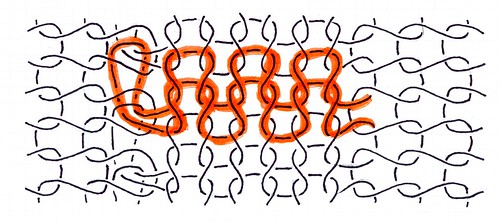 Sliding-loop entrelac join, two-sided, originally uploaded by fuzzyjay.
Sliding-loop entrelac join, two-sided, originally uploaded by fuzzyjay.I've never been totally happy with the way that entrelac joins look. To reduce bulk to a minimum, and to keep the stitches from looking too distorted, I have been using sliding-loop joins to connect pieces of knitting at right angles to each other, as in entrelac. When doing closed-form entrelac (such as a cube) there are times when you have to join three pieces together. Until a few days ago, I couldn't think of how to do that without decreases.. Then voila, it hit me. Here's how the structure looks. The pieces of knitting on both sides have live stitches (loops held on a needle or holder). In other words, the direction of knitting for them is toward the center. Pull a loop (one of them is shown in orange) through one of the raw stitches belonging to the piece on the right. This will secure the right piece of knitting to the center piece. Knit with the loop (knit rows going from right to left). Purl back (left to right), but before you do that, use the loop formed by turning the row to go through the knitted piece on the left, and chain these loops to each other, behind the fabric, to secure the left knitted piece to the center knitted piece. Soon, I'll describe the knitting operations to do this.
Monday, August 03, 2009
New entrelac joins for entrelac cube
Trying out different ways to join the squares in an entrelac cube. This came out OK... I was trying to avoid the distorted stitches that come about when you slip the first stitch of each row.
This cube uses sliding-loop joins instead of decreases to join selvedges to raw stitches.
To pick up stitches from selvedges, I had to figure out how to find the thread between the last stitch of one row and the first stitch of the next.This is not trivial, since the edge stitches become the infamous knots-and-looseness. Through experimentation, looking at the knitting, putting it down in disgust and returning to it hours later, I have become somewhat adept at scooping out that particular bight of yarn.
"A" newer entrelac
I re-drew this diagram to match better the other one(s). I have a "C" as well, but it's just hand-drawn at this point.
B newer improved entrelac
Tinkering with an entrelac alphabet. The "B" was one of the more complex shapes I was considering, so it's neat to be able to figure out the entrelac version. This is the second draft of the design. I improved the original version by eliminating as many cast-on edges as I could, and by rearranging the order of squares to make it a little more logical.
Sunday, August 02, 2009
Holding an entrelac heart

Finished the entrelac heart. As with most of my entrelac designs, this uses a continuous thread of yarn with one small grafted seam at the end. Actually, I don't graft even that seam any more, since there is a way to chain that seam closed. There is a little sewing to secure that last stitch, is all.
